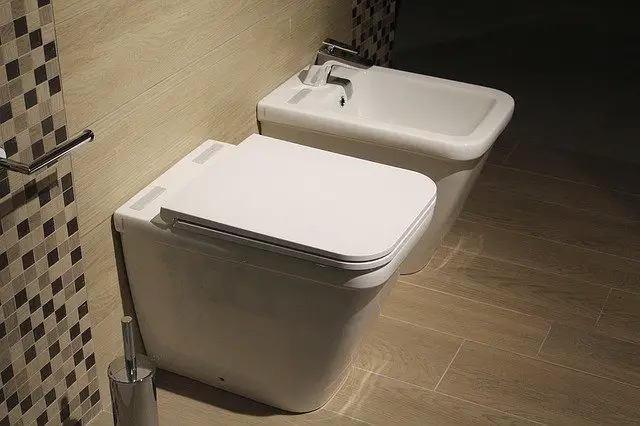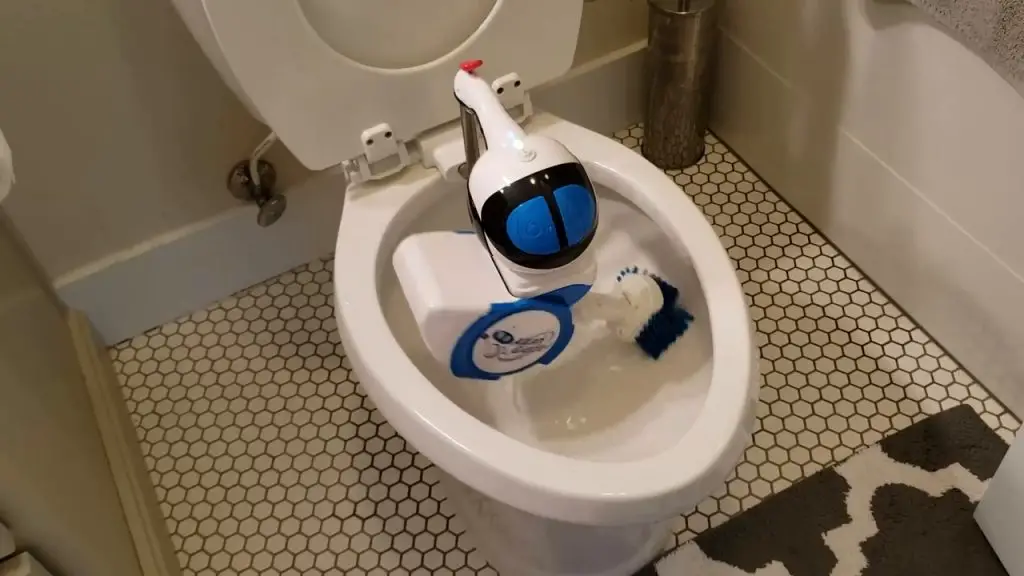How To Clean Toilet Siphon Jets (Quickly & Easily!)

Many toilets operate using siphon jets, which are openings at the underside of the rim that releases water flow into the bowl to initiate the toilet’s flush. They’re angled to spin in a circular direction, for increased effectiveness.
Since these jets are out of sight, it’s sometimes difficult to determine if they’re being properly cleaned or maintained.
Occasionally they can clog and are prone to bacterial growth when not functioning correctly because they exist in a moist and dark location. (Keep in mind, your toilet stays surprisingly clean due to its regular water flow.)
If your jet is clogged, your toilet won’t flush as effectively. Sometimes you’ll be able to obviously tell if there is a jet issue when flushing. The water will either be released straight down the bowl or bubble and sputter.
If you notice this, then you likely have a clogged jet, though it isn’t always that straightforward. If your toilet is taking longer to drain, it’s also a sign that your jets aren’t releasing with the same amount of pressure, indicating they’re clogged.
Inspecting your siphon jets is your best bet in determining whether they’re clogged, and what they’re clogged with.
Using a small mirror, look at the underside of the toilet bowl to see the jets. If clogged, you’ll either notice dark orange and black spots, or light and scaly deposits. Orange spots indicate a bacterial issue, while scale indicates mineral deposits. It is possible for both problems to exist at the same time.
Bacteria forms on toilets when there isn’t adequate water flow through them. Getting rid of it is a process of killing as much bacteria as you can.
You’ll need a strong detergent to kill the bacteria, either detergent or bleach. Choose based on your manufacturer recommendation. You don’t want an abrasive cleaner, as that can damage your toilet’s porcelain.
Make sure you have heavy duty gloves, a bucket, and a brush as well. Additionally, you’ll need something to scrape the jets with. This can either be a wire, like from a coat hanger, though pipe cleaners can also be effective.
If the deposit is small, you can make a paste using baking soda and vinegar that will usually get the job done without much effort. This method easily and effectively cleans the jet exteriors.
When mixing, make sure it’s a thick enough consistency to stick to the porcelain.
Turn off the water valve for the toilet and flush it to remove the water from the bowl. Using a small mirror, look under the rim to determine where you need to work.
If you’re using the baking soda and vinegar paste, apply it first and scrub gently using a toilet brush. You want the paste to get as far into the jets as possible. Let it sit for a half-hour then scrub again to scrape off the bacteria. Use the mirror to check progress and repeat if necessary.
This is a much deeper clean than the previous method. As before, you want to empty the toilet bowl and see how dirty the jets are. Using either a wire or narrow brush, insert it into the jets and gently scrape it to remove any deposits. Be extremely gentle since porcelain can scrape and crack easily.
Once that is done, apply the bleach or detergent around the rim and let sit for 15 minutes. Use your toilet brush to clean the underside of the rim and check to see if the toilet is clean.
Mineral deposits occur if the water in your area is hard, or full of sediment and minerals. You may notice evidence of this if your toilet perpetually looks dirty, despite constant cleaning. Other appliances may also be affected, as well. If this issue persists, you may need to install a water softener to reduce the mineral levels in your water.
Minerals are cleaned out using essentially the same procedure, but it’s a little more difficult since they have a tougher hold to the porcelain than bacteria. Like before, you’ll want to treat the jets before scraping for an easier clean, this time using vinegar.
You’ll need a mirror, gloves, a brush, and a bucket for this procedure, as well. Instead of detergent, you’ll need vinegar. There are two different cleaning methods, one using a spray bottle, and the other using duct tape.
You can use both methods or just one, depending on how much buildup you need to remove. If you find yourself having to repeat the process to remove the deposits, add borax, citrus juice, or bleach to the mixture. The added components should work better to break down the deposits.
You’ll want to do the same task of turning off the toilet’s water valve and flushing the toilet. Using your mirror (and gloves), inspect the underside of the toilet bowl to see where you’ll need to clean.
Bring a cup of vinegar to boil and allow it to cool enough to put into a spray bottle. Then spray the jets and areas in need of cleaning and let sit for about an hour. The mineral deposits should come loose and trickle down the bowl. Afterwards, use your wire or brush to gently scrape the jets. Repeat as needed until the toilet is clean.
Once that is done, use your regular toilet brush and cleaner to clean the bowl.
Clean out the toilet using your standard brush and cleaner to make sure the rim is as clean as possible. Then turn off the water and flush to make sure there’s no water in the bowl.
Double check that no water is draining into the bowl and wait for it to dry completely. When it’s dry, securely place duct tape under the rim, firmly covering the jets.
Take about a gallon of vinegar and fill the tank, then flush. The duct tape will seal the vinegar into the jets and allow to soak. Leave it for at least an hour, though longer is better. Remove the tape to check the jets and repeat as needed. Using your regular brush, scrape off any remaining debris.
Open the waterline and flush the toilet again to clean and clear the bowl.

Once you’ve done a deep clean of your siphon jets, you can keep them clean and clear with regular maintenance.
For bacterial buildup, either wipe your toilet down with bleach to regularly clear it out. For a more persistent problem, occasionally flush the toilet with a tablespoon of bleach in the overflow tube. Don’t use hard or abrasive cleaners in the tank, since they can cause the rubber parts, like the flapper valve, to wear and break. This could also void the manufacturer warranty if significant damage occurs as a result.
To clear consistent mineral buildup, occasionally pour warm vinegar into your tank and let sit for a half-hour before flushing. This should be enough to break up any mineral deposits as they form. Use your wire or brush to clean the jet openings and wash regularly with your standard brush and cleaner.